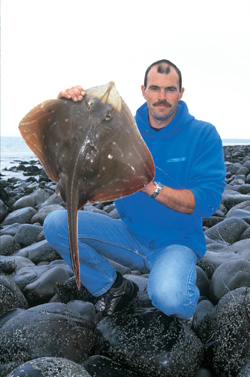There are many venues around the country where anglers can experience the thrills of landing many different species of ray. If you want to know how, then read on…
RAYS are actually members of the shark family. They may not have the razor sharp teeth that are associated with their close relatives, but they do have a skeleton that is made of cartilage, which is a tough, fibrous substance, not nearly as hard as bone.
Many rays have spines on their tails too, which can poison other animals when stung. Some rays have long, whip-like tails, other species have short tails, others even have rows of thorns covering most of their body as a defence against predators.
The colour variation among rays is huge and can even vary significantly between male and female in some species. However, the colouration is there to serve one purpose only and that is to camouflage the fish from its prey.
There are four main species of ray that can be caught from many venues around the UK shoreline, with the most typical ones being the thornback, spotted, small-eyed and big blondes.
As a general rule of thumb, much of the same tackle and tactics that are used for general beach fishing can be used for ray fishing. The thing that differs is the baits, which vary from region to region according to availability and personal preference.
Whatever species of ray you intend to target you can learn more here because we have condensed all the top information into 10 Shore Fire Winner tips.
So, next time you are on the beach you too can be a successful ray angler.
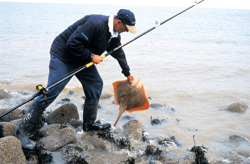 |
| Apart from thornbacks, most other rays are more active at night. |
1 Know Your Quarry
It is important to know the times when rays are feeding and in coastal waters before endeavouring to catch one.
Thornback rays are generally caught all year round in southern coastal waters and head north during the warmer summer weather. However, spotted rays, blondes and the small eyed species start to appear from as early as May and stay with us until September.
Thornbacks can be caught day or night while the other three species tend to be more active during the night, as these nocturnal feeders use the dark as cover to target their prey.
They can show during the daylight hours when the water is murky because the conditions resemble darkness.
The best tides to fish at night are big ones without a full moon. This is because the fish tend to go off the feed on a lighter night, so check the moon cycle before heading off.
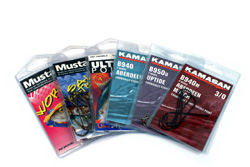 |
| Use a long shanked hook to make unhooking easier. |
2 Hooked Up
Rays have a habit of swallowing baits deep down because of the nature of their crushing mouths. A hook with a short shank can be taken in deep, which makes hook removal difficult. It is important to use fairly long shank hooks for ease of removing them from the fish’s mouth, while doing as little damage to the fish as possible.
Matching the hook to the bait is also necessary because when using large fish baits you should use large hooks. It is also important not to bury a hook in the bait, but don’t use a hook that is too large so that the bait cannot be properly secured to it.
For example, if you are using a six-inch long sandeel, then a size 2/0 to 3/0 hook is ample as it can pass through the eel, doing little damage as well as leaving a good section of the hook bend protruding to snare the fish.
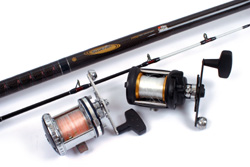 |
| Rods for rock fishing are ideal for powerful rays. |
3 Rods ‘n’ Reels
Rays are very powerful fish and can put an immense amount of stress on inadequate tackle. This is even more noticeable in a strong tide as they can use their bodies like a kite, which can put extreme pressure on the most powerful of rods and reels.
We recommend that you use a suitably strong rod combined with a reel to match. The sort of rod required for the task is one with a powerful butt section and a strong enough tip to hold its own as a ray takes off in the tide. Rods that are used for tournament casting or rock fishing are ideal.
The reel choice should be one with a good clutch that adjusts easily and can hold plenty of line in case a big fish is hooked, as big rays are capable of stripping lots of line off the clutch. A reel with a big spool is also necessary if you are using heavy running line. Such a reel ensures that there is enough mono on the reel to cast far enough to the feeding fish.
The secret is to balance the rod and reel so that they are working together, making sure that you are in total control of the fish.
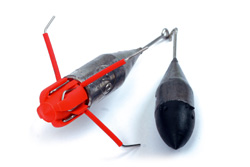 |
| Plain leads are often better than grip leads – they help you find the fish! |
4 Leads Can Be Plain
When fishing a sandy bottom, probably one of the smartest ideas is to use a plain lead.
The reason behind this is that rays tend to sit on bait as they eat it. If you used leads with grip wires, there is a very good chance that the fish would feel the wires and swim away leaving the bait alone. On the other hand a plain lead will roll around until it finds a hole or gully, which is likely to be a fish-holding spot.
The ray will then lay on top of the bait before eating it. This often registers on the rod tip as small twitches, which is when the fish is manoeuvring the bait towards its mouth.
Because of the size of the ray’s body the fish often covers the entire trace as it settles down on top of the offering. If it feels anything uncomfortable, like a spiked lead, the likelihood is that it will lose interest.
Lead size is also important because if you are using big baits, then you will need a lead suitably big enough to cast it out to sea. If you are fishing ordinary size baits a normal 150g lead will suffice.
5 All Rigged up
There are two main types of rigs that are popular to use when targeting rays. The first rig is for clean beach use, which is a single clip down Pennell rig with a long snood of at least 36 inches (below left).
Many years of experience with ray fishing has shown that this is the most effective rig to use in this situation. Two and three-hook rigs do not seem to work so well as the single snood rig.
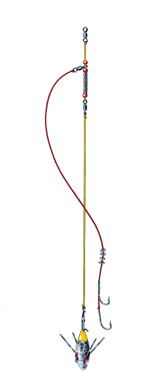
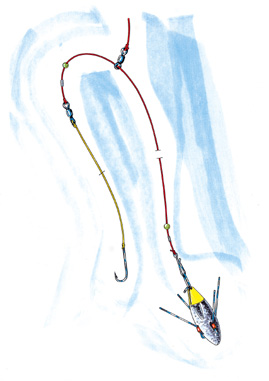
The other type of rig is for rough ground fishing and that is the pulley rig (above right). Again the hooks are in Pennell form for the best possible hook up. The reason for using a pulley is so that the fish cannot get the lead caught up in the rocks and become snagged, leading to a lost fish and gear.
Like the rig name suggests, it involves a pulley mechanism, which runs through a swivel. When a fish is hooked the weight of the fish will pull the lead up towards the swivel and above the fish, which means the lead is high enough in the water to avoid snagging on any rocks or debris.
Again, the emphasis is on the single snood rig because when fishing for rays the real secret is to keep it as simple as possible.
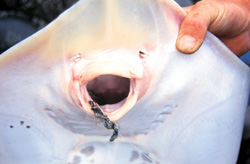 |
| Wait until the fish moves off before setting the hook. |
6 Shy Biting Rays
A noticeable thing is how sensitive the bites can be. A ray glides along the seabed in search of food using its acute sense of smell. Once it has located a food source, it lowers itself down onto the meal and starts to eat it.
This registers on the rod tip as a gentle rattle. Then, once it has finished off its meal, it swims off again looking for its next snack. This is the time that you can be sure that a ray has taken your bait as you can actually watch your line go down tide as it swims away – or the rod tip continues to arch over.
The key is to watch the rod tip closely at all times because that first telltale twitch as it settles over the bait is when you know that there is a fish interested. You must wait until the lead breaks out before striking to set the hook. Strike any earlier and you might miss the fish altogether.
Another way to do this is to pick up the rod as it twitches and literally feel for the fish. When the line tightens, you know the fish is definitely on the hook.
Be careful not to leave you rod unattended for too long, though, because a good-sized ray can pull all your gear into the sea as it swims off.
7 Bait Variations
The bait you use depends largely on the species of ray you intend to target, along with the time of year and the natural food that is available at that time.
Thornbacks are especially partial to king ragworm, crab, squid, mackerel and herring. Small eyed and spotted rays are more likely to take launce, mackerel, squid and sandeel.
When the crabs are peeling you will often find that this is by far the best bait because this is what the rays are naturally feeding on and looking for.
For the small eyed and spotted species one of the absolute top all-round baits is sandeel. Whether it is fresh or frozen all depends on the day and it is always best to go on a session with a selection for best results.
Ultimately the best plan of action is to contact a local fishing tackle shop where advice can be obtained as to what is working best at the time. A bit of local knowledge goes an extremely long way, so don’t be afraid to ask.
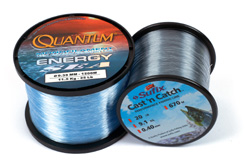 |
| Choose your line according to how far out you are fishing and what the sea bed is like. |
8 Direct Line
The sort of line to use depends very much on the area you wish to fish and the tactics that are required.
If the fish are at close range then 40lb line straight through will do, as it can take the stress of a lob and is more than strong enough to deal with the biggest of fish. This is also a good tactic over rough ground as it means that there is no weak link where the leader knot usually would be. If the seabed is rough then an 80lb leader is recommended to cope with the abrasion from the rocks.
If the fish are at range, then you have no choice but to use 15lb running line and an 80lb shockleader to reach them.
With regards to the snood it is important to use no less than 35lb breaking strain because of the abrasive pads that effectively form the rays teeth. As a fish is being reeled in, those pads can wear through lighter breaking strain lines very quickly.
Always use good quality lines because it would be a great shame if you hooked into that fish of a lifetime only to find that your line wasn’t up to the task.
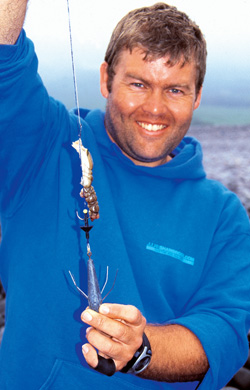 |
| A clipped down rig with a long snood is a good set-up. |
9 Pressure’s On
Every now and then a ray will sit on the bait and point blank refuse to move. You know the fish is hooked, but no matter how hard you pull, it just won’t give an inch.
What is actually happening is that the fish is using its large body mass as a big vacuum, a bit like a giant sucker on the sea bed. You are more likely to think that you have become snagged up and you’ll want to pull for a break. But don’t rush into things, because that could cost you the fish of a lifetime.
The way to deal with this is with a constant, steady pressure that will eventually lift the fish’s head and move it off the seabed. Once you get its head up it will start moving. Continue with the pressure because the secret is to get the fish up to the surface.
Once it is up it is relatively easy to reel it in, but while the fish is still submerged, it can use its body like a kite and put lots of stress on your gear. This is the time when many rays are lost, so use patience and get the fish up as quickly as possible.
10 Handle With Care
One of the most important things to do when ray fishing is handle the fish with care and release it as soon as possible to create as little stress as possible.
We would not recommend the use of a gaff, but we do know that anglers will use them on occasions. If you do need to use one then the only place you should gaff a ray is on the outer edge of its wings. This will do very little damage, whereas anywhere else could eventually lead to the fish’s demise. Even if it does seem to swim away it could possibly bleed to death.
Having got the fish out of the water, to pick one up there are a couple of soft areas on either side of its eyes where you can put you fingers in for a good grip.
Never put your fingers in the rays’ mouth because they do bite hard and can crush your fingers. And be careful with thornbacks as they have sharp spines all over their bodies that can leave you with some nasty cuts on your hands.
Another ray, which we haven’t mentioned in this article as it is not a common sight around UK shores, is the stingray. These have one, or in some cases, two spines on their tail and you must avoid these at all costs.
Stingrays can do serious damage to unsuspecting anglers, which could result in a trip to casualty.
Use a sling to weigh your catch and once done return the fish by helping it swim so that it can regain its strength.
This allows oxygen to pass through the gills and when the fish is ready to go it will let you know by giving a couple of flaps of its wings and gently gliding into the depths.


